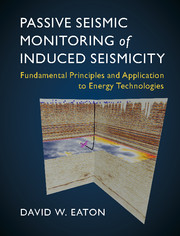 Passive Seismic Monitoring of Induced Seismicity
Passive Seismic Monitoring of Induced Seismicity Appendix C - Data Formats
Published online by Cambridge University Press: 07 June 2018
Summary
Various data formats are used for digital storage of microseismic data. A legacy data format that is still widely used in the oil and gas industry is called SEG Y (Barry et al., 1975). This format was introduced in 1975 by the Committee on Technical Standards of the Society of Exploration Geophysicists (SEG) for exchange of demultiplexed data and was revised in 2002 (Norris and Faichney, 2002). The term demultiplexed means that data samples are stored as sequential time series, in contrast to multiplexed data in which data samples are stored sequentially by channel number. The designation “Y” was chosen as this format specification replaced the previous standard, known as the SEG “Ex” format.
The SEG Y format was developed for use with magnetic tapes and contains three distinct types of data blocks. The first two blocks at the start of a standard SEG Y file represent the reel-identification header. This header starts with a block contains a 3200-byte free-form textual description of the data. This typically uses American Standard Code for Information Interchange (ASCII) format, but it was originally specified to use the Extended Binary Coded Decimal Interchange Code (EBCDIC) format developed by IBM. This was defined to contain 40 images of 80-character punch cards, where each card image should contain the character “C” in the first column. The second 400-byte binary block begins at byte 3201 of the reel-identification header and contains parameters that affect the whole file and that are crucial for processing the data. Some of the fields are considered mandatory, others are optional, while others are left undefined to allow for flexibility. Examples of defined reel-identification header binary fields include:
• Sample interval in microseconds (bytes 3217–3218);
• Number of samples per trace (bytes 3221–3222);
• Data sample format code (bytes 3225–3226);
• Number of 3200-byte extended textual file header records following the binary header (bytes 3505–3506).
These parameters are stored as integer values and the first three example parameters listed above are considered mandatory.
- Type
- Chapter
- Information
- Passive Seismic Monitoring of Induced SeismicityFundamental Principles and Application to Energy Technologies, pp. 299 - 301Publisher: Cambridge University PressPrint publication year: 2018


